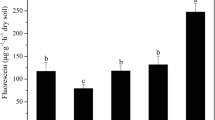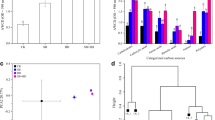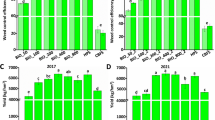Abstract
Soil continuous cropping obstacles lead to yield and economic losses in agriculture. Reductive soil disinfestation (RSD) is an effective technology for alleviating it. However, the key factors influencing microbial community composition and how do they promote functional transformation of core microbes under RSD practice remain poorly understood. Hence, a short-term field experiment was performed integrating real-time polymerase chain reaction, average well color development (AWCD), and MiSeq pyrosequencing to investigate relationships between environmental factors and microorganisms in five different disinfestation treatments, i.e., untreated monoculture soil (CK), soil with high temperature heating (HT), soil with dazomet (DZ), RSD with sugarcane bagasse (SB), or with bean dregs (BD). The results showed that compared to non-RSD treatments, both RSD treatments significantly increased soil microbial abundance and soil available K and organic matter (OM). Further analysis found that available K and OM were the key factors inducing microbial community change. Additionally, relative to non-RSD treatments, the relative abundances of phyla Proteobacteria, Acidobacteria, Rokubacteria, and Ascomycota were higher, whereas those of Actinobacteria, Gemmatimonadetes, and Basidiomycota were lower in RSD treatments. Changes in microbial diversity and abundance led to variation of soil microbial community functions. AWCD and community function prediction showed that, in contrast with non-RSD treatments, soil metabolism activity significantly increased, bacterial community functions including terpenoids and polyketides metabolism, signal transduction and cell motility increased, and the number of saprotroph fungi increased under RSD treatments. Overall, RSD incorporated with sugarcane bagasse or bean dregs efficiently improved soil fertility, and considerably increased soil microbial activity and function, which may benefit future sustainable agriculture production.
Key points
• Reductive soil disinfestation can alleviate continuous cropping obstacles by improving soil fertility.
• Organic matter and available potassium as the key factors affected microbial community reconstruction and function.
• Reductive soil disinfestation can improve soil metabolic activity and functional diversity by altering microorganism community.
Graphical abstract







Similar content being viewed by others
Data availability
The community sequences data (including fungal and bacterial) of all treatment in this study were deposited in NCBI under accession number SRA298170.
Code availability
Not applicable.
References
Cao SB, Sun FQ, Lu D, Zhou Y (2019) Characterization of the refractory dissolved organic matters (rDOM) in sludge alkaline fermentation liquid driven denitrification: Effect of HRT on their fate and transformation. Water Res 159:135–144. https://doi.org/10.1016/j.watres.2019.04.063
Chaudhry V, Rehman A, Mishra A, Chauhan PS, Nautiyal CS (2012) Changes in bacterial community structure of agricultural land due to long-term organic and chemical amendments. Microb Ecol 64:450–460. https://doi.org/10.1007/s00248-012-0025-y
Chen HJ, Zhao S, Zhao JM, Zhang KK, Jiang J, Guan ZY, Chen SM, Chen FD, Fang WM (2020) Deep tillage combined with biofertilizer following soil fumigation improved chrysanthemum growth by regulating the soil microbiome. Microbiologyopen 9:e1045. https://doi.org/10.1002/mbo3.1045
Chen J, Guo QK, Liu DH, Hu C, Sun JW, Wang XB, Liang GQ, Zhou W (2020) Composition, predicted functions, and co-occurrence networks of fungal and bacterial communities - links to soil organic carbon under long-term fertilization in a rice-wheat cropping system. Eur J Soil Biol 100:103226. https://doi.org/10.1016/j.ejsobi.2020.103226
Chen YH, Yang XZ, Li Z, An XH, Ma RP, Li YQ, Cheng CG (2020) Efficiency of potassium-solubilizing Paenibacillus mucilaginosus for the growth of apple seedling. J Integr Agr 19:2458–2469. https://doi.org/10.1016/S2095-3119(20)63303-2
Devi R, Kaur T, Kour D, Rana KL, Yadav A, Yadav AN (2020) Beneficial fungal communities from different habitats and their roles in plant growth promotion and soil health. Microbial Biosystems 5:21–47. https://doi.org/10.21608/MB.2020.32802.1016
Galgani F, Cadiou Y, Bocquene G (1991) Routine determination of enzyme kinetics using plate reader. Biotechnol Bioeng 38:434–437. https://doi.org/10.1002/bit.260380413
Gao JX, Pei HX, Xie H (2020) Synergistic effects of organic fertilizer and corn straw on microorganisms of pepper continuous cropping soil in China. Bioengineered 11:1258–1268. https://doi.org/10.1080/21655979.2020.1840753
Garland JL (1996) Analytical approaches to the characterization of samples of microbial communities using patterns of potential C source utilization. Soil Biol Biochem 28:213–221. https://doi.org/10.1016/0038-0717(95)00112-3
Goldford JE, Lu NX, Bajic D, Estrela S, Tikhonov M, Sanchez-Gorostiaga A, Segre D, Mehta P, Sanchez A (2018) Emergent simplicity in microbial community assembly. Science 361:469–474. https://doi.org/10.1126/science.aat1168
Huang XQ, Liu LL, Wen T, Zhang JB, Wang FH, Cai ZC (2016) Changes in the soil microbial community after reductive soil disinfestation and cucumber seedling cultivation. Appl Microbiol Biot 100:5581–5593. https://doi.org/10.1007/s00253-016-7362-6
Huang XQ, Zhao J, Zhou X, Zhang JB, Cai ZC (2019) Differential responses of soil bacterial community and functional diversity to reductive soil disinfestation and chemical soil disinfestation. Geoderma 348:124–134. https://doi.org/10.1016/j.geoderma.2019.04.027
Jaiswal AK, Elad Y, Paudel I, Graber ER, Cytryn E, Frenkel O (2017) Linking the belowground microbial composition, diversity and activity to soilborne disease suppression and growth promotion of tomato amended with biochar. Sci Rep-UK 7:44382. https://doi.org/10.1038/srep44382
Jiang SQ, Yu YN, Gao RW, Wang H, Zhang J, Li R, Long XH, Shen QR, Chen W, Cai F (2019) High-throughput absolute quantification sequencing reveals the effect of different fertilizer applications on bacterial community in a tomato cultivated coastal saline soil. Sci Total Environ 687:601–609. https://doi.org/10.1016/j.scitotenv.2019.06.105
Jiao YL, Chu GM, Yang ZA, Wang Y, Wang M (2020) Bacterial diversity in the rhizosphere of anabasis aphylla in the Gurbantunggut desert, China. Curr Microbiol 77:3750–3759. https://doi.org/10.1007/s00284-020-02177-y
Khadka RB, Marasini M, Rawal R, Testen AL, Miller SA (2020) Effects of anaerobic soil disinfestation carbon sources on soilborne diseases and weeds of okra and eggplant in Nepal. Crop Prot 135:104846. https://doi.org/10.1016/j.cropro.2019.104846
Li X, Li XF, Li YY, Dai XZ, Zhang QZ, Zhang M, Zhang ZQ, Tao Y, Chen WC, Zhang MX, Zhou XY, Yang S, Ma YQ, Zhran M, Zou XX (2021) Improved immobilization of soil cadmium by regulating soil characteristics and microbial community through reductive soil disinfestation. Sci Total Environ 778:146222. https://doi.org/10.1016/j.scitotenv.2021.146222
Li YL, Wang BY, Chang YF, Yang YT, Yao CZ, Huang XQ, Zhang JB, Cai ZC, Zhao J (2019) Reductive soil disinfestation effectively alleviates the replant failure of Sanqi ginseng through allelochemical degradation and pathogen suppression. Appl Microbiol Biot 103:3581–3595. https://doi.org/10.1007/s00253-019-09676-4
Liu CJ, Gong XW, Dang K, Li J, Yang P, Gao XL, Deng XP, Feng BL (2020) Linkages between nutrient ratio and the microbial community in rhizosphere soil following fertilizer management. Environ Res 184:109261. https://doi.org/10.1016/j.envres.2020.109261
Liu HK, Wang C, Xie YL, Luo Y, Sheng MP, Xu F, Xu H (2020) Ecological responses of soil microbial abundance and diversity to cadmium and soil properties in farmland around an enterprise-intensive region. J Hazard Mater 392:122478. https://doi.org/10.1016/j.jhazmat.2020.122478
Liu LL, Chen SH, Zhao J, Zhou X, Wang BY, Li YL, Zheng GQ, Zhang JB, Cai ZC, Huang XQ (2018) Watermelon planting is capable to restructure the soil microbiome that regulated by reductive soil disinfestation. Appl Soil Ecol 129:52–60. https://doi.org/10.1016/j.apsoil.2018.05.004
Liu LL, Kong JJ, Cui HL, Zhang JB, Wang FH, Cai ZC, Huang XQ (2016) Relationships of decomposability and C/N ratio in different types of organic matter with suppression of Fusarium oxysporum and microbial communities during reductive soil disinfestation. Biol Control 101:103–113. https://doi.org/10.1016/j.biocontrol.2016.06.011
Liu N, Shao C, Sun H, Liu ZB, Guan YM, Wu LJ, Zhang LL, Pan XX, Zhang ZH, Zhang YY, Zhang B (2020) Arbuscular mycorrhizal fungi biofertilizer improves American ginseng (Panax quinquefolius L.) growth under the continuous cropping regime. Geoderma 363:114155. https://doi.org/10.1016/j.geoderma.2019.114155
Liu XY, Xiao R, Li RH, Amjad A, Zhang ZQ (2020d) Bioremediation of Cd-contaminated soil by earthworms (Eisenia fetida): Enhancement with EDTA and bean dregs. Environ Pollut 266:115191. https://doi.org/10.1016/j.envpol.2020.115191
Mofokeng MM, Habig J, Amoo SO, du Plooy CP, Mashela PW, Moeletsi ME, Venter S, Araya HT (2020) Differences in soil microbial communities and enzyme activity due to the application of bioslurry under cultivation. South African J Plant Soil 37:283–291. https://doi.org/10.1080/02571862.2020.1761468
Poret-Peterson AT, Albu S, McClean AE, Kluepfel DA (2019) Shifts in soil bacterial communities as a function of carbon source used during anaerobic soil disinfestation. Front Env Sci-Switz 6:160. https://doi.org/10.3389/fenvs.2018.00160
Price GW, Langille MGI, Yurgel SN (2021) Microbial co-occurrence network analysis of soils receiving short- and long-term applications of alkaline treated biosolids. Sci Total Environ 751:141687. https://doi.org/10.1016/j.scitotenv.2020.141687
Qiao K, Wang ZT, Wei M, Wang HY, Wang Y, Wang KY (2015) Evaluation of chemical alternatives to methyl bromide in tomato crops in China. Crop Prot 67:223–227. https://doi.org/10.1016/j.cropro.2014.10.017
Rajan SSS, Fox RL, Saunders WMH, Upsdell M (1991) Influence of pH, time and rate of application on phosphate rock dissolution and availability to pastures. Fertil Res 28:85–93. https://doi.org/10.1007/bf01048860
Silveira MHL, de Siqueira FG, Rau M, Silva LD, Moreira LRDS, Ferreira-Filho EX, Andreaus J (2014) Hydrolysis of sugarcane bagasse with enzyme preparations from Acrophialophora nainiana grown on different carbon sources. Biocatal Biotransfor 32:53–63. https://doi.org/10.3109/10242422.2013.872634
Sławski M, Tarabuła T, Sławska M (2020) Does the enrichment of post-arable soil with organic matter stimulate forest ecosystem restoration—a view from the perspective of three decades after the afforestation of farmland. Forest Ecol Manag 487:118525. https://doi.org/10.1016/j.foreco.2020.118525
Song DL, Chen L, Zhang S, Zheng Q, Ullah S, Zhou W, Wang XB (2020) Combined biochar and nitrogen fertilizer change soil enzyme and microbial activities in a 2-year field trial. Eur J Soil Biol 99:103212. https://doi.org/10.1016/j.ejsobi.2020.103212
Sun K, Chen HL, Zhang QY, Li SY, Liu QZ, Si YB (2020) Influence of humic acids on fungal laccase-initiated 17α-ethynylestradiol oligomerization: transformation kinetics and products distribution. Chemosphere 258:127371. https://doi.org/10.1016/j.chemosphere.2020.127371
Tan XY, Liao HK, Shu LZ, Yao HY (2019) Effect of different substrates on soil microbial community structure and the mechanisms of reductive soil disinfestation. Front Microbiol 10:2851. https://doi.org/10.3389/fmicb.2019.02851
Trentini CP, Campanello PI, Villagra M, Ferreras J, Hartmann M (2020) Thinning partially mitigates the impact of Atlantic forest replacement by pine monocultures on the soil microbiome. Front Microbiol 11:1491. https://doi.org/10.3389/fmicb.2020.01491
Wang K, Chu C, Li XK, Wang W, Ren NQ (2018) Succession of bacterial community function in cow manure composing. Bioresource Technol 267:63–70. https://doi.org/10.1016/j.biortech.2018.06.028
Wang Q, Wang C, Yu WW, Turak A, Chen DW, Huang Y, Ao JH, Jiang YR, Huang Z (2018) Effects of nitrogen and phosphorus inputs on soil bacterial abundance, diversity, and community composition in Chinese fir plantations. Front Microbiol 9:1453. https://doi.org/10.3389/fmicb.2018.01543
Wang XJ, Zhang ZC, Yu ZQ, Shen GF, Cheng HF, Tao S (2020) Composition and diversity of soil microbial communities in the alpine wetland and alpine forest ecosystems on the Tibetan plateau. Sci Total Environ 747:141358. https://doi.org/10.1016/j.scitotenv.2020.141358
Wu JP, Guo FL, Jiao ZB, Zhou J, Qiu ZM (2020) The effect of monoculture and rotation planting on soil bacterial community structure at different elevation in Hubei. Soil Use Manage 37:667–676. https://doi.org/10.1111/sum.12612
Wu XL, Gu YC, Wu XY, Zhou XY, Zhou H, Amanze C, Shen L, Zeng WM (2020) Construction of a tetracycline degrading bacterial consortium and its application evaluation in laboratory-scale soil remediation. Microorganisms 8:292. https://doi.org/10.3390/microorganisms8020292
Yan DD, Wang QX, Mao LG, Ma TT, Li Y, Ouyang CB, Guo MX, Cao AC (2015) Interaction between nitrification, denitrification and nitrous oxide production in fumigated soils. Atmos Environ 103:82–86. https://doi.org/10.1016/j.atmosenv.2014.09.079
Yu LF, Wang SQ, Li TX, Han L (2021) Response of soil faunal communities to tea tree cultivars in the hilly region of western Sichuan. China Sci Hortic-Amsterdam 275:109701. https://doi.org/10.1016/j.scienta.2020.109701
Zhao J, Liu SZ, Zhou X, Xia Q, Liu X, Zhang SR, Zhang JB, Cai ZC, Huang XQ (2020) Reductive soil disinfestation incorporated with organic residue combination significantly improves soil microbial activity and functional diversity than sole residue incorporation. Appl Microbiol Biot 104:7573–7588. https://doi.org/10.1007/s00253-020-10778-7
Zhao J, Zhou X, Jiang AQ, Fan JZ, Lan T, Zhang JB, Cai ZC (2018) Distinct impacts of reductive soil disinfestation and chemical soil disinfestation on soil fungal communities and memberships. Appl Microbiol Biot 102:7623–7634. https://doi.org/10.1007/s00253-018-9107-1
Zheng Q, Hu Y, Zhang S, Noll L, Böckle T, Dietrich M, Wanek W (2019) Soil multifunctionality is affected by the soil environment and by microbial community composition and diversity. Soil Biol and Biochem 136:107521. https://doi.org/10.1016/j.soilbio.2019.107521
Zheng XF, Wang ZR, Zhu YJ, Wang JP, Liu B (2020) Effects of a microbial restoration substrate on plant growth and rhizosphere bacterial community in a continuous tomato cropping greenhouse. Sci Rep 10(1):1–11. https://doi.org/10.1038/s41598-020-70737-0
Zhu TB, Dang Q, Zhang JB, Müller C, Cai ZC (2014) Reductive soil disinfestation (RSD) alters gross N transformation rates and reduces NO and N2O emissions in degraded vegetable soils. Plant Soil 382:269–280. https://doi.org/10.1007/s11104-014-2160-3
Zhu TB, Zhang JB, Yang WY, Cai ZC (2013) Effects of organic material amendment and water content on NO, N2O, and N2 emissions in a nitrate-rich vegetable soil. Biol Fert Soils 49:153–163. https://doi.org/10.1007/s00374-012-0711-4
Acknowledgements
We really thank Yajun Hu, Mi Zhang, Yueyue Li, Mingxing Zhang, Sha Yang, and Wenchao Chen for their assistance with the experiments. In addition, thank are due to Xuexiao Zou and Rong Sheng for polishing the language of the manuscript. Anonymous reviewers are also thanked for their contribution to the final version of the manuscript.
Funding
This research was funded by the National Key Research and Development Program of China (2019YFD1000300), the Natural Science Foundation of Hunan Province (2020JJ5313), the Key R&D program of Hunan Province (2019NK2191, 2020NK2005), and the program of Changsha Science and technology (kq2004041).
Author information
Authors and Affiliations
Contributions
X.L. and Y.T. conceived and designed the investigation. J.C. and Q.Z.Z. conducted the experiment. X.L. and J.C. performed the statistical analyses, and created the figures and wrote the paper. Y.T., X.F.L., and X.Y.Z. reviewed and edited the manuscript. All authors provided feedback and contributed to improve finalizing the manuscript.
Corresponding author
Ethics declarations
Ethics approval and consent to participate
This article does not contain any studies with human participants or animals performed by any of the authors.
Consent for publication
All co-authors have agreed to the content and form of the manuscript for publication.
Competing interests
The authors declare no competing interests.
Additional information
Publisher's note
Springer Nature remains neutral with regard to jurisdictional claims in published maps and institutional affiliations.
Xin Li and Jie Chen contributed equally to this work.
Supplementary Information
Below is the link to the electronic supplementary material.
Rights and permissions
About this article
Cite this article
Li, X., Chen, J., Zhang, Q. et al. Microbial community responses to multiple soil disinfestation change drivers. Appl Microbiol Biotechnol 105, 6993–7007 (2021). https://doi.org/10.1007/s00253-021-11528-z
Received:
Revised:
Accepted:
Published:
Issue Date:
DOI: https://doi.org/10.1007/s00253-021-11528-z




